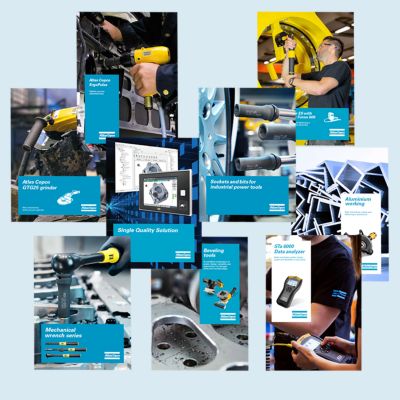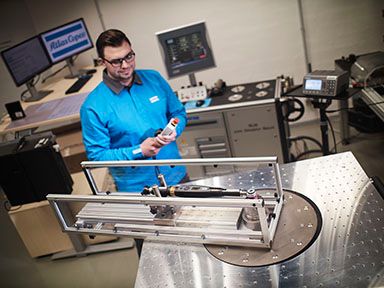High-quality hem flange bonding with E-Swirl application
Key quality factor in automotive BIW productions: filling the hems of folded sheets
Hem flange bonding is one of the most challenging joining methods in car body construction. Here, the focus is on the ideal distribution of material to achieve an optimal filling of the seam area and thus ensure structural stability and prevent corrosion. The application process of the adhesive has a significant impact on this.
Learn more about hem flange bonding:
Dive into the best practices, materials, and quality assurance techniques recommended by Atlas Copco to enhance production efficiency and ensure superior product quality. Download the brochures now!
Or keep on reading:
Explore an extract from our comprehensive Pocket Guide on hem flange bonding. Interested in learning more? Simply check the download box above to get started!
What is hem flange bonding and why is it important?
Hem flange bonding is an essential process in body-in-white (BIW) production, where the edges of metal sheets are folded and bonded using high-performance adhesives. This technique is primarily used for car doors, hoods, and trunk lids. It enhances crash safety, increases rigidity, and protects against corrosion.
Hem flange bonding is one of the most challenging joining methods in the body shop. The adhesive fulfills important structural properties, improves crash safety, and protects against corrosion. Other joining techniques, such as spot welding or riveting, are not suitable here, as they leave visible joints and compromise the aesthetic appearance. In hem flange bonding, two sheets are nested inside each other. The adhesive – often a one-component or two-component epoxy or a rubber-based material – is applied to the outer sheet. It is then bent around the inner sheet and folded over. During hemming, the adhesive is pressed, thus filling the hem area.

The hem flange process:
1. Nesting; 2. Pre-folding; 3. Final hem
Quality criteria for hem flange bonding

The long-term stability of this bond depends on the material distribution in the hem. The following criteria are relevant:
- A: 100-percent bonding between the inner and outer sheet
- B: Defined X-percent bonding between the inner and outer sheet
- C: Complete filling of the hem with adhesive
- D: Sufficient distribution of adhesive on the inside
If the hem is insufficiently filled with adhesive, this leads to the formation of cavities and air channels. During the subsequent e-coating process, these cavities fill with the liquid. This liquid then dries during the curing in the oven, resulting in air bubbles and wetting defects. In addition to visual defects, the hem flange also becomes susceptible to corrosion. The vehicle body has to be discharged for reworking. If, on the other hand, too much adhesive has been applied, or the adhesive bead was positioned incorrectly, this leads to unwanted material leaks. The component has to be reworked before painting to ensure that the e-coat bath is not contaminated or to avoid problems during cosmetic sealing – as a consequence, the material consumption and quality cost increase.
Material distribution: focus on the application
There are numerous factors in the complete joining process which may influence the material distribution in the hem – such as the choice of adhesive or the hemming method. One of the key influencing factors, however, is the application process itself. In general, automated robot-based adhesive metering and dispensing systems are used to control parameters such as material flow, temperature, pressure and application speed in a precise and repeatable manner. There are generally two suitable application patterns: a classic bead application and what is often referred to as a swirl application, where the material is applied in a swirling motion. Both applications can provide high-quality hem flange bonding in ideal conditions.

Application pattern of traditional bead application, swirl application and swirl application with constrictions.
Improved process reliability

Swirl application with constrictions: In areas where less material is required, the volume can be adjusted.
Nevertheless, the challenges in modern production and current trends, such as multi-material design and light-weight construction, put increasingly higher demands on the industry. Increasingly complex vehicle designs and part geometries require more dynamic robot movements and make access to the components more difficult. Application solutions must be flexible. The swirl application technique can offer several benefits here. While the bead application requires the application distance to the component to match the bead diameter, the swirl method allows larger distances of up to 50 millimeters.
Changing the distance does not affect the application pattern. This makes robot programming easier, allows higher speeds and facilitates accessibility, especially for complex geometries. At the same time, swirl applications ensure a material distribution optimized for hem flange applications – the same amount of material is distributed over a larger surface. The application is still precise with sharply defined contours. This has a positive effect on pressing in the folding process. Modern swirl applicators also offer the possibility of precisely adjusting the width of the application. In places where less material is required, the applied volume can thus be systematically reduced while still maintaining a consistently high application quality. This allows perfect adjustment of the bonding seam to the geometric shape of the flange. Material leaks and reworking can thus be avoided. At the same time, it reduces material consumption.
Quality assurance
With both bead and swirl applications, the quality of the material application can be additionally ensured by means of a visual inspection system. Inline camera-based quality monitoring systems detect errors regarding the width, continuity and positioning of the application immediately during application – without additional cycle time. Furthermore, some camera systems offer an automated bead repair function, for instance, in case of an interruption in the adhesive application.

Visual bead inspection
Discover more to enhance your processes








